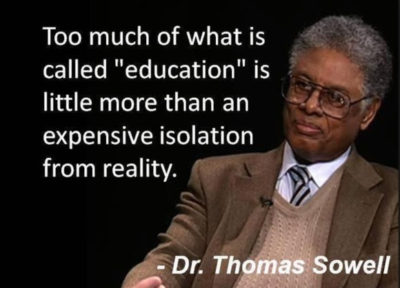It is coming time for us to choose between pleasant lies or painful truth. Do federal policymakers really know how to improve productivity in the American economy? The answer seems to be NO. Education is a large sector of the American economy. If educational results are an indication, the answer is definitely in the negative.
The last major shift in education
Educators, lawmakers, and the business community routinely complain about the performance of our education system. The American K-12 public education sector, especially the part serving inner-city children, and schools serving children from low-income families are not producing a quality product. They are not even producing a product that has the skills to be employable.
Beginning in 1965 the largesse of federal taxpayers has been extended to education. The expertise of federal bureaucrats has been brought to bear on education. In the wake of the Great Society, the number of pages of federal law that governed K-12 public schools increased from 80 to 360. The number of pages of federal regulations increased from 92 to almost 1,000. Federal spending per public school student tripled in the decade of the 1960s alone, adjusted for inflation.
Federal education mandates and spending increased. The number of public school administrators in local public school districts increased as well. In the years since 1960, the number of students increased by 40%. While the number of administrators increased by 137%. Why is that? Did it improve educational outcomes?
Not counted in that educational administrative growth is the increase in political bureaucracy. The number of state government officials needed to administer the 17 federal K-12 education programs has ballooned. According to its online directory, the Georgia State Department of Education has 147 staff members. They administer the federal programs. Each school district has staff devoted to managing those programs as well.
The road to hell
Federal programs were well-intentioned. They “help” students with special needs, migrant students, and students from low-income families. We have learned over the past few decades of social science research; good intentions do not always lead to great results. Since the early 1970s, the performance of 17-year-olds on national reading and math exams has been flat. There has been no improvement in student learning in those subjects.
Today we have more federal control; more federal, state, and local spending on public schools. We now have more administrators, teachers, and support staff. All of this has resulted in no improvement in national test results. There is something not working in our approach to education.
In fact, on a per public school employee basis, productivity in American public schools has been negative over the past 40 years. That statement means, productivity has declined. It has gone down dramatically because we are getting the same student achievement. We are getting the same result with significantly more public school employees today, and more spending as compared with 50 years ago.
Shouldn’t education keep pace with the economy?
Going back to the Great Society the leaders of the public K-12 education sector would have been tremendously happy to have had the 1.3% per year growth in productivity of the private-sector nonfarm labor sector. In fact, any productivity growth at all would be a positive indicator. Maybe we could manage a smile for even just, no dramatic decrease in productivity. In the same period we have continued to advance technology and achieve productivity growth elsewhere.
Clearly, it’s time to try something different in K-12 education. We should stop giving more authority over local schools to distant federal bureaucracies. Families should decide which educational settings are best for their children. We should stop demanding one size fits all is the only equal.
Dollars alone do not equalize people. Dollars should not be the measure of quality in education. Students’ educational results should be the measure of educational achievement. Are we going to stick with pleasant lies or are we going to accept the painful truth and find a better way forward?
